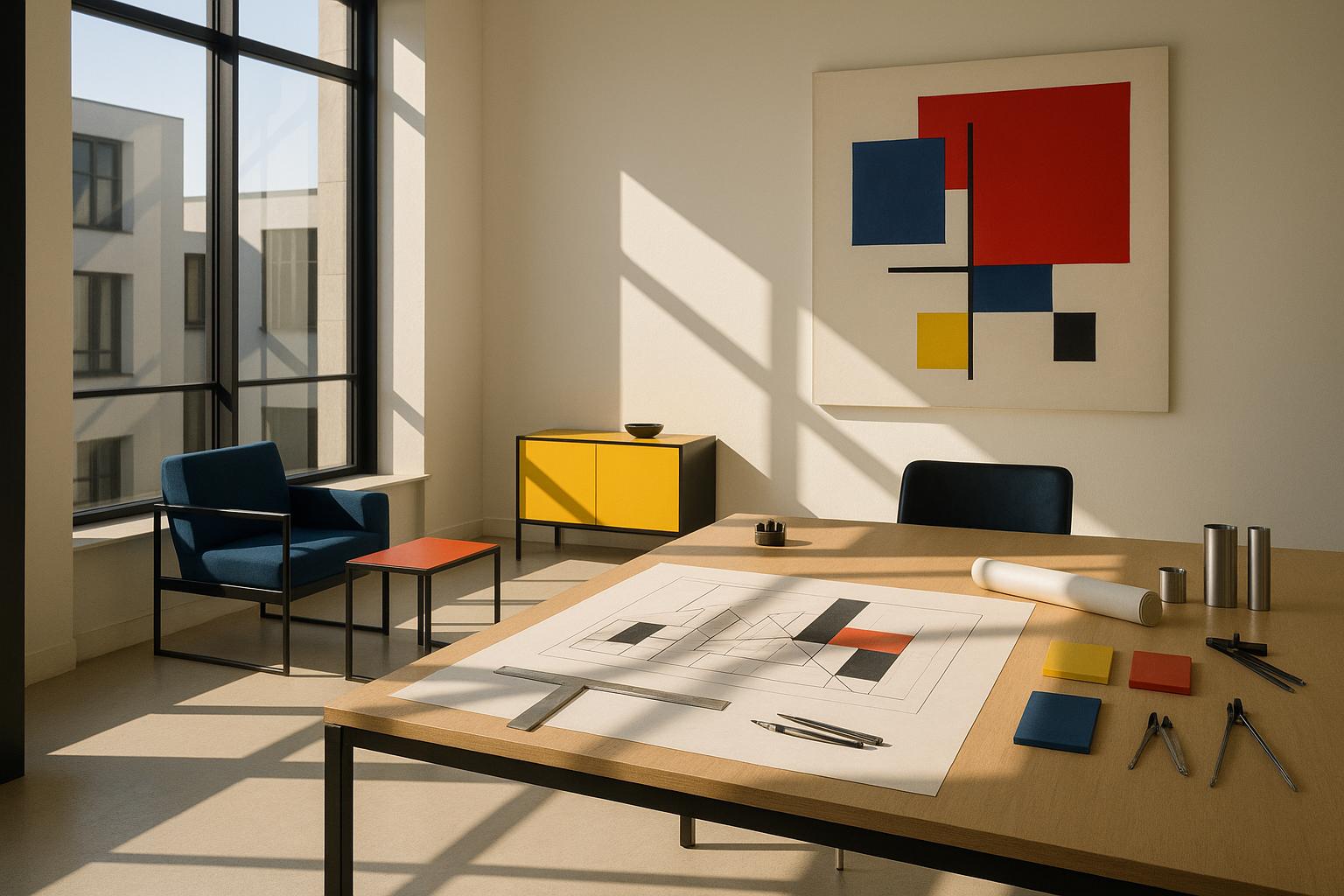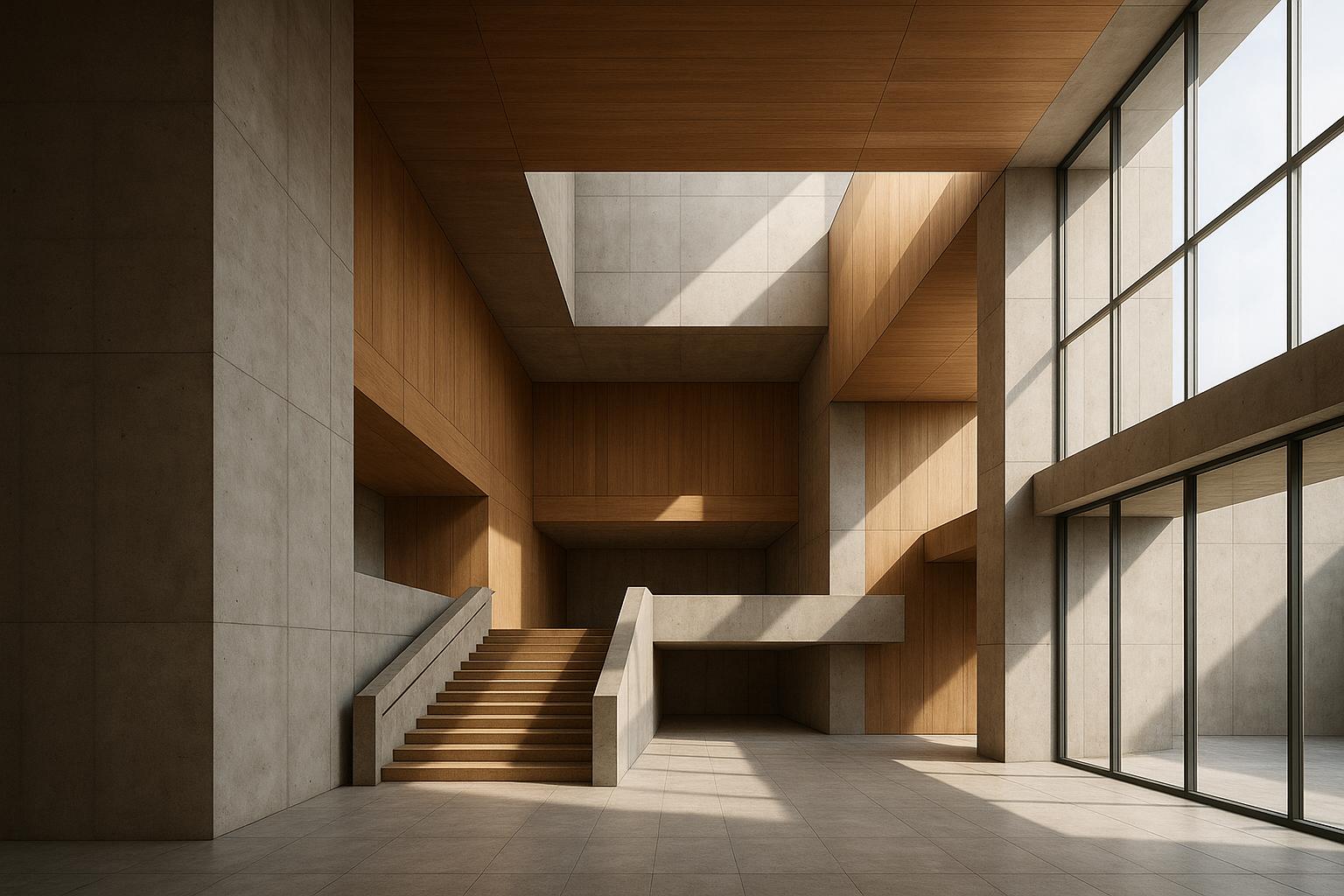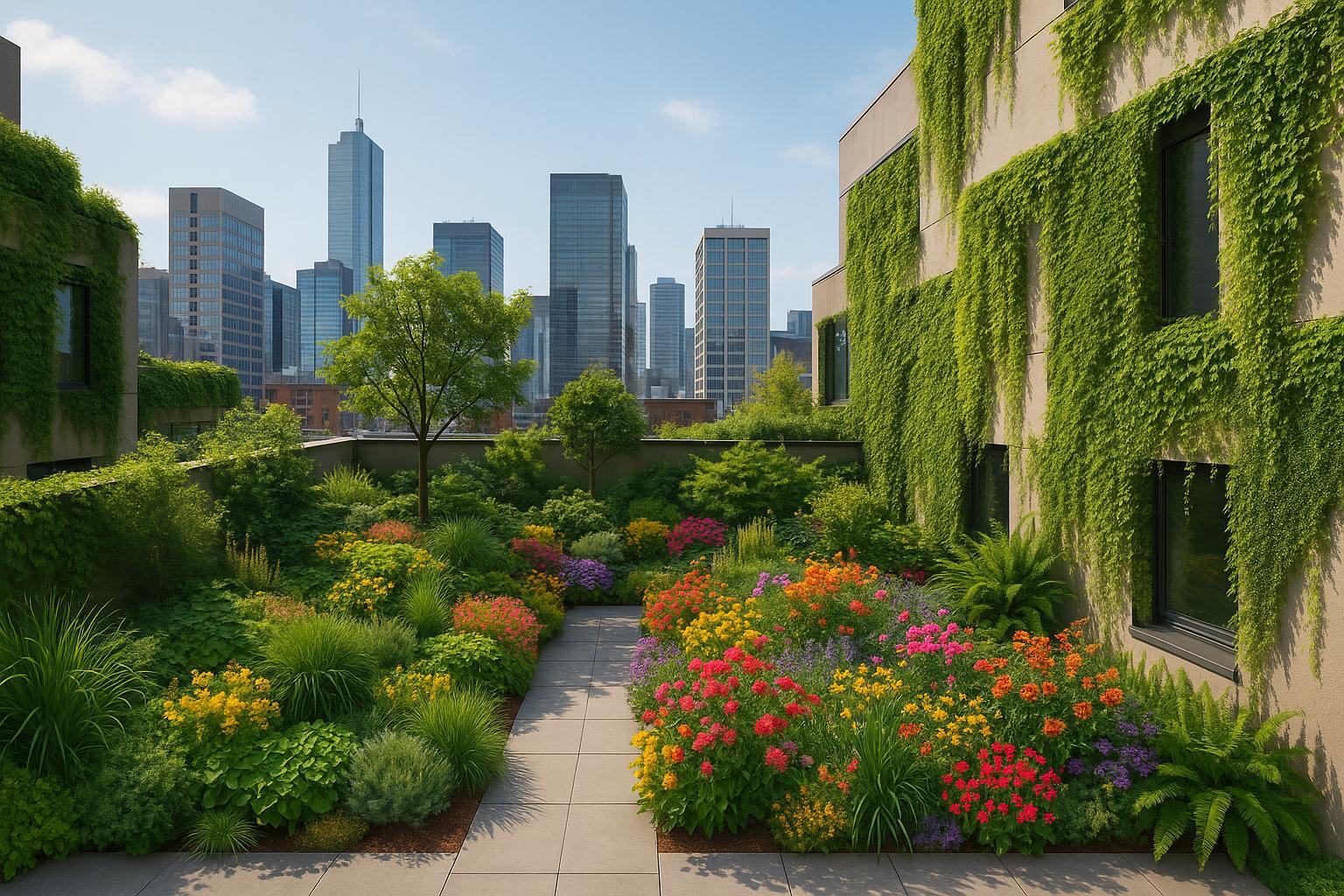North African mosques are known for their unique architectural style, blending Islamic principles with local traditions. Here’s a quick summary of their defining features:
- Courtyards and Water Elements: Central open spaces with fountains for spiritual purification and cooling.
- Square Minarets: Iconic towers used for the call to prayer, starting with the Great Mosque of Kairouan.
- Prayer Halls: Hypostyle layouts with rows of columns, often featuring a "T-plan" design.
- Decorative Patterns: Geometric designs, Kufic script, and carved stucco enhance both aesthetics and acoustics.
- Regional Styles: Moroccan mosques showcase vibrant tilework, Tunisian mosques emphasize domes and stonework, while Algerian mosques combine Andalusian and Ottoman influences.
- Local Materials: Mud-brick construction and natural resources are used to adapt to the climate.
These mosques prioritize intricate interiors over external grandeur, reflecting centuries of cultural and architectural evolution.
The Friday Mosque Revisited: the Meaning, Function, and Evolution of an Architectural Paradigm
Main Architectural Elements
North African mosques reflect a fascinating blend of religious principles and adaptations to the local environment, shaped by centuries of evolving design.
Courtyards and Water Elements
The courtyard (Sahn) is the centerpiece of North African mosque architecture, creating a harmonious link between the earth and sky. These open spaces are more than just architectural features - they allow for natural light and airflow while also serving religious purposes. Water features, such as fountains and pools, are often found within these courtyards. They symbolize spiritual purification and help cool the surroundings, evoking the imagery of the four rivers of Paradise mentioned in the Qur'an. Surrounding arcades, or riwaqs, provide much-needed shade and act as transitional zones between the courtyard and the prayer hall.
Minaret Styles and Functions
One of the defining features of North African mosques is their square-based minarets, which stand apart from the designs seen in other Islamic traditions. The earliest example is the minaret of Kairouan in Tunisia, built between 724 and 727 CE. Over time, these towers evolved into more elaborate structures, reflecting the artistic influences of different dynasties.
Three iconic examples highlight this evolution:
- Kutubia Mosque (1158): This mosque features a 67.6-meter-high minaret with a 12.5-square-meter base, incorporating a blind base and horseshoe arches.
- Great Mosque of Seville (1172–1182): Building on the Kutubia design, it adds intricate ornamentation, including the distinctive Shebka pattern.
- Hasan Mosque (1195–1196): This mosque represents the peak of this architectural progression, with its towering 80-meter height and a 16-square-meter base.
These minarets not only serve as visual landmarks but also play a functional role in calling worshippers to prayer, seamlessly connecting the external and internal spaces of the mosque.
Prayer Hall Structure
The prayer halls in North African mosques often follow a hypostyle layout, defined by rows of columns that support the roof. A unique "T-plan" layout is common, featuring a wider central nave leading to the mihrab and broader transverse aisles along the qibla wall. This arrangement draws attention toward the mihrab while accommodating large congregations.
An outstanding example of this design is the Great Mosque of Kairouan, which spans a width of 70.6 meters and a depth of 37.5 meters. It houses 414 columns and 17 intricately carved wooden doors.
"The unique harmony of this temple consists in the proportion and the number of these slender shafts upholding the building, filling, peopling, and making it what it is, create its grace and greatness. Their colorful multitude gives the eye the impression of unlimited." - Guy de Maupassant
Surface Decoration
Beyond their architectural structure, North African mosques are renowned for their intricate decorative elements. Geometric patterns, carved stucco, and Kufic script adorn their surfaces, creating breathtaking spaces that inspire spiritual reflection. A remarkable example is the Almoravid Great Mosque of Tlemcen, with its semi-transparent plaster dome near the mihrab. These decorations do more than enhance visual appeal - they also improve acoustics, helping sound travel evenly throughout the prayer hall, fostering a serene and meditative environment for worshippers.
Mosque Styles by Country
Mosque architecture across North Africa showcases a fascinating blend of regional styles, each uniquely adapting Islamic design principles to local traditions and influences.
Moroccan Mosque Design
Moroccan mosques are a striking fusion of Islamic architectural elements and Berber traditions. They are known for their intricate geometric patterns, iconic horseshoe arches, and vibrant zellij tilework. During the Almohad dynasty, mosque designs leaned toward a balance of simplicity and grandeur, while the Marinid period introduced elaborate wood and stucco decorations.
One standout example is the Hassan II Mosque in Casablanca. With its towering minaret reaching 689 feet (210 meters), it is a modern marvel of Moroccan architecture. Located on the Atlantic coast, this mosque skillfully combines traditional Moroccan craftsmanship with contemporary engineering techniques. Its design serves as a bridge between historical and modern architectural styles, influencing neighboring regions like Tunisia and Algeria.
Tunisian Mosque Elements
Tunisian mosque architecture draws heavily from the Aghlabid era, featuring domed structures and intricate stonework. A prime example is the Great Mosque of Kairouan, which became a model for mosque design across North Africa.
Key architectural features of the Great Mosque include:
- A double-arcaded courtyard supported by Roman and Byzantine columns
- A T-shaped prayer hall layout
- A prototype minaret standing 103 feet (31.5 meters) tall
These elements illustrate how Tunisia has preserved and adapted its architectural heritage over centuries.
Algerian Mosque Features
Algerian mosques reflect a rich combination of Andalusian, Fatimid, and Ottoman influences. The Great Mosque of Tlemcen, for instance, showcases a mihrab dome adorned with gold-colored vine patterns forming a 12-pointed star, which is pierced to allow natural light to filter through. Originally built in the late 11th century by Yusuf ibn Tashufin, it was later enhanced in 1136 by his son, 'Ali b. Yusuf.
Another notable structure is the Mosque of Qal'a Beni Hammad, which features a rectangular layout:
- Width: 184 feet (56 meters) from east to west
- Length: 210 feet (64 meters) from north to south
- Minaret height: 82 feet (25 meters)
The mosque’s square minaret reflects Andalusian design, while its arches draw inspiration from Fatimid traditions. This blend of styles underscores Algeria's role as a crossroads for diverse architectural influences in the region.
sbb-itb-1be9014
Building Materials and Methods
Mosques in North Africa showcase a remarkable ability to adapt to their environment by using locally sourced materials and construction techniques that have stood the test of time. These methods are tailored to endure the region's harsh climate, with two prominent approaches emerging: mud-brick construction and the strategic use of local resources.
Mud and Brick Construction
The Great Mosque of Djenné in Mali is a striking example of mud-brick architecture. Towering over 50 feet (15 m), it holds the distinction of being the largest mud-brick structure in the world. Built using sun-dried bricks known as ferey, along with earth-based mortar and plaster, the mosque rests on a 10-foot (3 m) platform to protect it from floods caused by the nearby Bani River.
Each material used in its construction serves a specific purpose:
| Material | Role |
|---|---|
| Earth/Clay | Primary building material |
| Straw | Reinforcement |
| Shea Butter | Waterproofing |
| Palm Wood | Structural support |
Another example of this technique is the Grand Mosque of Bobo-Dioulasso, where six-foot-thick walls naturally regulate indoor temperatures. Retired school librarian Sanon Mousa explains the benefits of this approach:
"The mud will keep us cool. The motor oil, clay, and cow dung will keep us dry. We've perfected this."
Using Local Materials
In addition to mud-brick construction, builders in the region make resourceful use of locally available materials to tackle climate challenges. The Sudano-Sahelian architectural style, for instance, incorporates timber beams called toron, which extend outward from walls. These beams not only provide structural support but also assist in maintenance and add a decorative touch.
Traditional materials offer several advantages:
- Thermal Regulation: Thick mud walls help maintain a comfortable indoor temperature.
- Affordability: Locally made, air-dried mud bricks cost just $0.10 each.
- Lower Environmental Impact: Unlike cement, which accounts for 8% of global CO₂ emissions, these materials have a much smaller carbon footprint.
Architect Francis Kéré critiques modern construction trends, saying:
"The reality is that cement construction is simply sexy. But it's bad sex. It is not producing comfort."
Architect Salima Naji adds:
"We have chosen artifice. We have chosen to detach ourselves from our origins. We have done this because we have forgotten the extraordinary benefits of these buildings in the heat. But we must remember, because we need it now more than ever."
The practicality of these methods is celebrated through annual upkeep rituals like the Crépissage, a community event at the Great Mosque of Djenné that reinforces the structure's durability and cultural significance.
Conclusion
North African mosques are a unique blend of pre-Islamic influences, Islamic principles, and local Berber traditions, creating a distinct architectural style that stands apart from their eastern counterparts. These mosques often prioritize intricate interior ornamentation over external grandeur, with modest vaulting adding to their understated elegance.
One of the most iconic examples is the Great Mosque of Kairouan, whose 32-meter (105-foot) minaret draws inspiration from Roman lighthouses. This structure serves as a powerful symbol of religious identity and reflects the region's rich historical and stylistic journey.
Preserving these architectural treasures is essential to safeguarding a legacy that showcases the region's contributions to art, science, and religion. Key features such as horseshoe arches, riad gardens, square minarets, and geometric patterns have not only defined North African mosques but have also shaped Islamic architecture far beyond the region. From the Mudéjar style in Spain to modern landmarks like the Sheikh Zayed Grand Mosque in Abu Dhabi, these design elements continue to inspire and evolve.
FAQs
What are the key architectural features of North African mosques, and how do they reflect the region's culture and environment?
North African Mosques: A Blend of Culture and Environment
North African mosques stand out for their domes, minarets, and open courtyards, which reflect the rich heritage of the region. Elements like horseshoe arches and detailed stucco designs reveal a fascinating mix of Islamic, Moorish, and Andalusian influences, shaped over centuries of interaction and exchange.
The environment has also played a key role in shaping these structures. Many are constructed with local materials such as mud and clay, which not only suit the hot, dry climate but also align with sustainable building practices. A perfect example is the Great Mosque of Djenné - the world’s largest mud-built structure. It stands as a testament to how architecture can harmonize with its surroundings while maintaining a strong connection to cultural roots.
How do mosque architectural styles differ between Morocco, Tunisia, and Algeria?
Mosques in Morocco, Tunisia, and Algeria reflect a fascinating mix of architectural styles shaped by their unique histories and local traditions.
In Morocco, mosques stand out with their intricate tile work, horseshoe arches, and detailed stucco patterns. These design elements showcase a blend of Berber, Islamic, and Andalusian influences. One signature feature is the tall, square minaret, epitomized by the iconic Koutoubia Mosque in Marrakech.
Tunisian mosques, such as the Great Mosque of Kairouan, are renowned for their hypostyle layouts featuring rows of columns, geometric motifs, and elegant Arabic calligraphy. Unlike their Moroccan counterparts, Tunisian mosques often rely on stone rather than brick, a nod to local construction practices.
In Algeria, mosque architecture is a fusion of Maghrebi, Ottoman, and Hispano-Moresque styles. Key elements include grand domes, intricate tile work, and thoughtfully arranged prayer areas that balance functionality with aesthetic appeal.
Though rooted in shared Islamic traditions, the mosques of these three countries beautifully illustrate their distinct regional identities and historical narratives.
What makes the construction of North African mosques sustainable and long-lasting?
The mosques of North Africa stand as a testament to both resilience and practicality, thanks to their reliance on traditional building methods and locally available materials. Materials like adobe, rammed earth, and stone are not just plentiful in the region but also naturally effective at insulating interiors. This keeps the spaces cool in scorching temperatures without the need for energy-draining cooling systems.
Moreover, building techniques such as mud brick construction and rammed earth walls have proven their ability to withstand extreme weather over time. Simple upkeep, like occasional replastering, ensures these structures remain functional and long-lasting. These practices reflect a deep-rooted harmony between resourceful design and enduring craftsmanship, shaped by centuries of wisdom.


